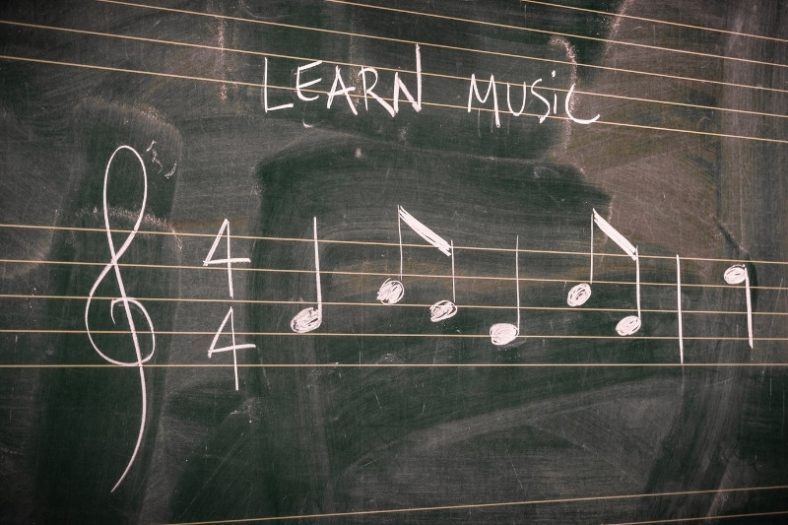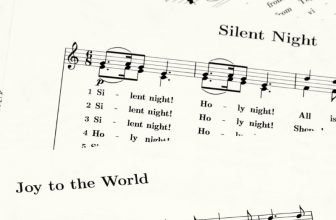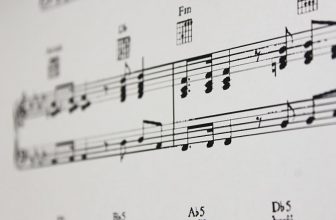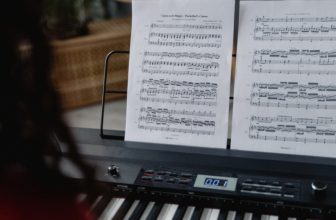10 Tips to Learn Music Theory Way Faster

Music theory is one of the most essential parts of music education and there is no point at which you say “ok, I’m done with music theory, I know everything now”. Music theory involves the most basic aspects such as learning notes, rhythms, musical signs, scales, keys, solfege, and harmony.
Learning these basics helps you to read and write music. Besides, music theory also involves the most advanced aspects such as analyzing and composing music. Students use these skills for many different positions in their future careers such as performer, ensemble/orchestra member, conductor, arranger, or composer. These positions require them to use their listening and analytical skills as well as their performance technique.
In my observations, for many music students, the beginning point of music theory is musical ear training, even before learning notes, as it is vital for any kind of musicianship. But there usually is something missing in higher music theory education.
Traditional theory education doesn’t consider that ear training should go along with each level of music theory learning in practical and physical ways including the most advanced exercises such as arranging, composing, and conducting. It’s because music theory becomes more than an academic study when students are exposed to practical senses that construct a sense of musical structure.
In this article, you’ll find tips to learn music theory faster both individually and being part of a group with explanations of why music theory is complicated and how you can change your perspective on this complication.
Contents
- 1. Active Listening
- 2. Learning Harmony by Ear
- 3. Practice Intervals
- 4. Recognizing Intervals by Ear
- 5. Singing Intervals
- 6. Chords
- 7. Chord Progression Dictation
- 8. Practice Conducting
- 9. Be Part of a Band or Ensemble
- 10. Try Improvising
- Why is Music Theory Complicated?
- Practical Music Theory
- Self-teaching
- Summary
1. Active Listening
Anyone studying music theory is well aware that the process involves a lot of reading and writing down notes. An important part of reflecting is to consider the thinking process of the moment’s creation. You can choose a simple and short piece of music you like. While listening to it multiple times, try to understand what’s going on.
Start with the leading sound you hear no matter vocal or instrumental. What does it do rhythmically? Is there a rhythmical pattern that repeats? What are the first and the last notes (or just sounds) you hear? Which note (sound) do you hear the most? Do you hear something unexpected?
And then, listen to the same piece one more time paying attention to the back vocals or instruments. You don’t have to hear every single detail, you can keep the expectation low. What you need to do is to look for any connection between sounds and rhythms. Are there repeated melodies on the bass? What does the leading line do when the bass line is making a melody and vice versa?
You can do this kind of exercise for any kind of music anywhere and anytime you want. After some practice, you’ll see that you’ll be able to analyze a music piece even the first time you hear it.
In formal music education, musical analysis is often focused on classic works in order to uncover and recognize the characteristics of these works. Using musical analysis, students identify patterns of a specific musical form, composing style due to an era, or composer. They may then compare the work analyzed with others.
When producing a composition, it is helpful to use the reflecting moments as building blocks. Developing your reflecting skill, you’ll be able to find out the personal and cultural background, non-formal and formal learning techniques, real-life purposes, and limits in your music as well, not only others’.
2. Learning Harmony by Ear
Learning chords and chord progressions is a method that many popular musicians usually use. This is the basic entrance to harmony. In classical music education melodic dictation and chord dictation are mostly used practices, while jazz musicians practice with chord progression dictation without waiting for too long.
To be more specific for those who don’t know the terms yet, chords are used to create vertical combinations of pitches. The movement of these chords underneath the leading line creates progression. When the melody goes along with the progression, it stands on top of it. The musical style is defined by how a progression is structured.
Even if you’re a beginner, learning to play chords and chord progressions might be a challenge. You may come by people saying that all you have to do is keep studying plenty of songs by ear and you’ll begin to recognize these chord progressions. In this case, the truth is that you really need to do this kind of exercise. Simply repeating the process will be enough. You’ll soon be able to recognize chord progressions by hearing them. For example, I-VI-II-V will be obvious to you. You may find it unrealistic, but it really works.
In classical harmony, chord progressions are more regular. Mostly it is predictable how the progressions will happen and which cadences will end the phrases once you learn the rules.
Once you learn this method, also classical harmony lessons will be much easier and you’ll learn all those scary numbers and terms much faster. Two essential skills are required for this method which includes intervals and chords.
3. Practice Intervals
An Interval is the calculation of the space between two notes. Simply, sit on a piano and play two notes separately in an ascending or descending way. Then count the keys between them. Remember the semitones and whole tones explanation. The total number of whole tones will indicate the interval number and the number of semitones will indicate if it’s a Major or minor interval.
You can take this as a fundamental part of ear training. You should consider intervals as building blocks. You’ll be learning how to recognize them. There are ways to train your ears to achieve this and associate intervals with notes and also develop relative pitch with extra practice.
You’ll have to learn, hear, recognize, and sing many intervals but it’s better to start with unisons, ascending Major 2nds and minor 2nds, and then go on until the octave. There are 13 ascending and 13 descending intervals. Unison is only one note, not an interval but as you may hear unison singing or unison playing instruments, it makes sense to practice with someone to sing the same note or play the same note.
It’s important to practice with a small amount at a time and step by step. Don’t go practicing 5 or 6 intervals, but go with only two intervals at the beginning to avoid confusion.
4. Recognizing Intervals by Ear
This is a tricky point because most people stop ear training with the intervals once they get the concept. But in fact, what they learn is recognizing the numbers and names of the intervals and what they sound like. This is not the point of this exercise and it’s not enough.
You start with unison. You play the same note two times. When you hear two same separated notes, you should recognize them as being the same notes. Then you go on with hearing how the minor 2nd ascending sounds. If you want to memorize the interval you’ll need to repeat it on different notes over and over again until it becomes natural.
Basically, repetition is the key to success in music exactly like learning a foreign language, that’s for sure. Especially if you are not born in a musician family and did not start at a very young age, repetition will be the way out for you.
Another way is taking a song, or a piece of music that you like (music that you have already reflected on can be even more helpful) and finding out the intervals used in this piece, you can easily memorize the intervals. The first two notes of many iconic musical pieces will be helpful to memorize how an ascending or descending interval sounds. You can find multiple supportive examples at Interval Song Chart Generator
At this moment, the second fundamental exercise comes up:
5. Singing Intervals
You need to be able to sing the intervals. You have to be able to reproduce it by yourself even without getting the help of an instrument because of many different reasons:
If you can sing an interval being aware of which interval it is, that means that you’ve integrated the sound into your brain. You would then be capable of reproducing that interval rather than simply hearing it for yourself and then recognizing it; which would indicate that you had fully switched on that ability.
There’s no need to have a good vocal technique or be on the perfect pitch to do that. You are free to reproduce these sounds as you wish. It’s not a practice to develop your singing skills after all. Singing the right note is enough.
6. Chords
Another fundamental thing you need to learn is chords. Without knowing and recognizing chords, it wouldn’t be possible to learn chord progressions. It doesn’t matter if it’s a Major triad or dominant seventh chord, you’ll be able to recognize it using your interval skills because, in the end, the chords are made of multiple vertical intervals.
Once you come over the interval exercises, they work in the same way also for internalizing chords.
The first thing is that you won’t have all of the chords in a chord progression with you. It’s easier to play songs by ear than to figure out which of the 12 major chords, the 12 minor chords, and every other chord there are. You don’t have to figure that out.
It’s a good thing that most music is diatonic, which means that it’s all in a single key. It is possible to generate only seven distinct chords while working with the diatonic scale, which is used in nearly all music. Each note in the scale will make up a different chord.
Ex. G minor
D E F G A Bb C
D minor E diminished F Major G minor A minor Bb Major C Major D minor
I II III IV V VI VII
Of these seven chords, there’s one chord that hardly ever gets used. As you can imagine, it is the diminished chord. The diminished chord is very rarely used, actually, we can say that it’s almost never used. So for now, you can forget about this chord.
In this case, six chords remain. Three of these chords are minor chords; D minor, G minor, and A minor. These are the I, IV, and V chords of the minor scale.
On the other hand, we have three Major chords; F Major, Bb Major, and C Major. These are the I, IV, V of the relative Major scale which is F Major.
Using this as a guide, we can see how to play all Major key music within the D minor. To begin in F Major, we simply move the scale. We may now play all of our Major and minor music in the same key. These six chords will be used both in major and minor pieces. To learn to play diatonic music by ear, you just need to learn to identify these chords.
7. Chord Progression Dictation
As a result, we know that our key has just six chords. However, we may take it a step further and begin learning common chord progression structures. Again, it’s best to concentrate on a single common shape that begins with a D minor chord. I’d like to discuss one of the strategies for transcribing chords by ear before we get into what a typical form is.
You must first transcribe the bass line before you can transcribe the chords. Because the bass line almost always plays the chord’s root note. That is to say, if the chord is a D minor chord, D will be in the bass. A will be in the bass if there is an A minor chord. It’s possible to do it the opposite way around. The presence of an F in the bass line indicates that we are in the key of F Major, which is above D minor.
Chord Inversion: You can play the chords over the root or the 3rd in the bass, or the 5th in the bass, or other chordal tones, including any other chordal tone that’s not the root. This concept is called chord inversion.
To become a professional musician, you’ll spend a lot of time learning to hear chords in inversion through ear training. Even though you’ll undoubtedly hear about it in music class, chord inversion is rarely employed. The root position is used for most chords (keeping it in the bass). There’s a good reason for it.
As a general rule, chords are stronger when played at their root position. Composers typically prefer to play the chord’s fundamental note. For this reason, listening to the bass note is all you need to transcribe a chord progression.
Ex. Chord Progression in D minor scale (see also the first example and compare)
D minor C (Major) Bb (Major) C (Major)
I genuinely believe that the harmonic progression dictation, besides being a higher-level version of melodic or chord dictations, makes much more sense for any learning level. Because it is not only about writing correctly what you’ve heard but it is about understanding the whole piece of music. It’s simpler and more instructive at the same time. I know that it’s intimidating at the beginning, so I will try to keep it as simple as possible.
At this point, you’re free to make the chord progression dictation with a piece of music that is familiar to you using a sheet of paper or even not.
8. Practice Conducting
The conductor uses a language of ideographic hand gestures to shape the music of a group. which is referred to as “conduction.” The name of the conducting method in the music theory class is the Conduction method. Butch Morris formed this method with different gestures and signs as an alternative to conducting ensemble music. His book “The Art of Conduction” is kind of a handbook in which he describes his vision and his method.
Morris was passionate about the musicians to come up with the first ideas, the motifs. For him, this was an opening door to change, loop, transform, and regrow as humans and musicians. You can see it here.
Extraordinary jazz musician and cornet virtuoso Butch Morris, the method’s founder, saw it as a way to access and deepen fundamental musical abilities so that they might be used to the development of new music. His method was aiming to develop transposing, arranging, analyzing, and reflecting skills, much faster thanks to his cognitive approach.
He says that it doesn’t matter where someone comes from in terms of their aesthetic, socioeconomic, or cultural background. Individuals’ interpretations and contributions to the communal knowledge we receive are the focus of conduction.
Conduction is a method you can use to teach music theory principles to pupils, allowing them to build a repertoire of sensory and motor skills such as listening skills, structural understanding, analytical proficiency, and performing techniques.
9. Be Part of a Band or Ensemble
It is possible to use the “conduction” to practice any basic theory competency, including scale fluency, harmonic process, and counterpoint, as well as forms of other genres. I agree that using the Conduction method in the music theory classroom is an efficient way to meet the needs of today’s students.
When students are part of an ensemble, also having the possibility for each to conduct the ensemble, they learn more than just how to play their instruments.
Being part of an ensemble or a group no matter how big the group is (it may include even two people) is already one of the best practices for ear training, self-awareness, and comparison in a good sense (which is necessary), besides learning how to build confidence, leading, sharing ideas and also respecting other ideas.
There are multiple benefits of this conducting technique in a theory class. As a result of dictation and analysis of conducting, students can engage in analytic mode through recordings created in class.
The “Extra Dimension” of Morris
Signs and gestures are used in the process of the conduction method. The practice makes the conductor move. “The Art of Conduction” by Morris is a guide to this method that includes a dictionary describing the directives, signs, and gestures. However, in most performance circumstances only a tiny percentage of the vocabulary is actually used.
Signs tell you what to do, but gestures show how the conductor moves his fingers, hands, arms, or baton. While a gesture of the baton is musically understood when it is made with an outstretched fist, it is interpreted when it is made with an extended arm for example.
The main signals and gestures allow conductors to manage tonality, tempo, timing, development, dynamics, articulation, and score-related instructions, among other things. The left hand indicates what will occur, while the rhythmic pulses are carried out by the right hand usually with a baton.
So maintaining eye contact with him is essential. Just to give you an idea, imagine the Conductor extending his left hand flat and palm up to signal the impending arrival of a sustained tone direction.
As soon as the musicians have made eye contact, the baton is lowered, and they begin to sound like one. Although this tone may be chosen, most people choose to leave it up to their own personal preferences. The ability to conduct an orchestra is shared by all members of the group.
10. Try Improvising
Improvising is one of the most liberating musical practices and it is a great tool to learn music theory faster. You’ll need to practice each piece of information you’ve ever had until that moment but this time with a difference. Everything needs to be flowing while improvising. Actually, going with the flow is the condition of improvisation.
There is no way to do it while calculating the intervals, chords, or progressions. It is extremely beneficial also to understand your struggles better. A perfect exercise also for the self-teaching moments. You can do these exercises individually and/or in an ensemble. Both ways are enriching in different ways.
Why is Music Theory Complicated?
A theory is there to help you understand something, in other words, it explains why and how something makes sense. Verbal explanations aren’t always necessary or helpful.
Traditional music education places a high value on music theory learning, while suggestions for more embodied and active approaches to music education rarely mention theory learning. Besides symbolic and imaginative language, we theorize with our bodies, actions, and thoughts in the physical world.
This is why some students or beginners have difficulties with learning music theory. When there are not enough practical exercises along with the theory lessons, at a certain point things you learn don’t make sense anymore. You don’t know where to put them in your individual musical practice.
All musicians should better understand and internalize how music theory works, and this article aims to give some useful and easy advice on that. Music theory education is proposed for the learner to continue to grow individually and create a transformative process of finding their potential as they live and work within a community, society, and the world. So, beginners or students should think about this idea in a physical way.
Practical Music Theory
Here, I want to share with you one of my personal experiences as I was a music student myself. As I grew up in competitive classical music environments, talking about where I was struggling had never been easy or helpful. This kind of situation is not helping at all for development and finding your own path as a musician.
So, even though you don’t have the opportunity to ask someone why something is not working for you, you are aware of what’s going on with you. This is already a good starting point.
When I was a teenager, I passed the conservatory exams with the highest grade in my hometown. Professors in the commission told me that I had almost an absolute musical ear. Everything was perfect at the time.
Later though, when I started to study solfege, harmony, and everything that music theory may include, I was completely confused, nothing made sense, I didn’t know how and where to use all that information and besides I started to feel like I wasn’t able to hear notes correctly.
I was way too far from experiencing it as a natural process in which I participated. Unfortunately, this situation took a while until I had an AHa moment at an international world music festival.
Most folk musicians from all over the world were singing, playing, improvising their own arrangements and even compositions by ear and nothing else. They didn’t even know music theory. Popular musicians often don’t take or take little formal music education to learn to play an instrument, sing and compose.
Self-teaching
From that moment, I started to focus on listening to music, playing the clarinet and piano, and analyzing the arrangements of the music pieces only by ear for a while. All the music theory courses I had until that moment incredibly started to make sense. I was relieved that I didn’t have any kind of hearing damage and that I was able to use the music theory in different ways.
All this new process was more sophisticated, more engaging. Each moment, I realized a major flaw in music theory teaching. Practical and physical music theory learning, even if it was a self-teaching process, saved my career and it can be a solution also for many others.
You’ll realize that many musicians who are making non-formal music don’t have formal music theory knowledge. The point is that music theory may be the least important goal of a popular musician. Self-teaching is the most common way that popular musicians learn music.
Of course, there is no magic touch, you’ll need to practice, read and write but you’ll definitely have more fun while flowingly practicing these musical activities. Methods I may suggest you are informal music theory experiences. They encourage you to improve your listening, understanding, singing, creating, and improvisational abilities.
Being exposed to music theory before you are expected to read and write it correctly is what you’ll be focusing on. As a result of these informal experiences, you will be better prepared for formal training in notation reading and writing in the classroom.
Summary
Practical music theory means applying musical knowledge in taking part in an existing musical culture. By understanding the music you hear, you’ll be able to understand other forms of notation like written or sheet music better. This way, it’s easier for you to learn and play songs that are already familiar because you already know how they sound.
Music theory is very important for musicians and students of music, but not many pop musicians learn it because they don’t use written notation. Self-teaching means that you will need to practice a lot and invest more time in learning how to play by ear than if you were taking formal lessons.





